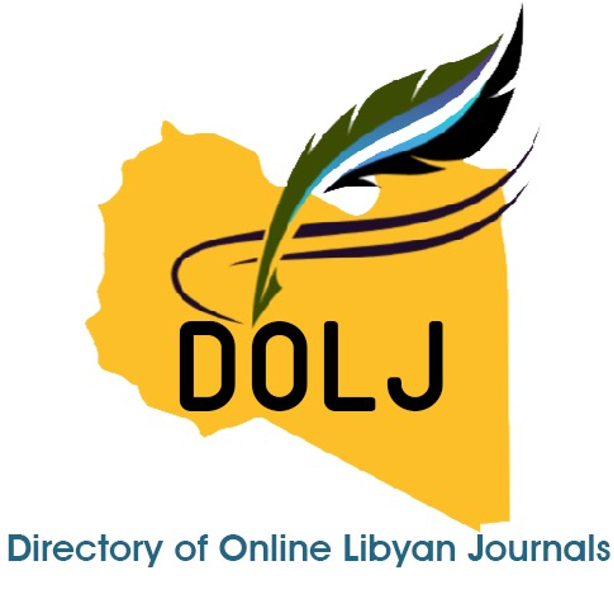Detection of the mycotoxin Zearalenone from the filtrate of Fusarium oxysporum isolated from onions
DOI:
https://doi.org/10.36602/jsba.2022.14.45Keywords:
Onion, Fusarium oxysporum, Zearalenone - ELISA READERAbstract
In this research, samples of onions were collected from several areas in the city of Misurata,represented in Al-Dafniyah, Tomina, Zawiat Al-Mahjoub, Al-Ghiran, Quzir, Al-Jazeera, Misurata Markaz, Ras Al-Toba, Al-Zarrouk and Qasr Ahmed, during the period from June to November 2018. Sampling, which was represented in a kilo of onions from each region, where the number of complete samples was 50 samples, and for each sample the Fusarium oxysporum grew 3 replicates, where the number of dishes was 150 dishes, then the F.oxysporum was isolated From the basal part of the onion plant (discoid stems and fibrous roots) that showed symptoms of the disease, and then grown on solid nutrient medium Potato dextrose agar (PDA) and then grown in test tubes containing liquid Nutrient broth (NB) at 28 ±2”C in order to measure the wet and dry weight of the filter and also for the purpose of detecting the zearalenone toxin from the filtrate. The process of detecting the mycotoxin zearalenone was carried out in two steps. First, the sample was prepared and added 100 μ l of the Bufffer comes with the kit for the test on 600 μ l of the filtrate in special tubes with a cap with simple shaking to ensure the homogeneity of the solution together, Secondly, injection with special materials consisting of a standard solution. enzyme conjugate, substrate, chromogen and stop solution, and zearalenone readings were taken by ELISA READER device, where it was proved through this research that F. oxysporum is one of the fungi that secrete zearalenone toxin.
References
1. ديوان, مجيد والبهادلي, علي (1985) أمراض النبات. مؤسسة المعاهد الفنية, ص ) 344 ( بغداد, العراق.
2. أبوغنية , عبد النبي (1986) أمراض المحاصيل البستانية . جامعة طرابلس , طرابلس , ليبيا .
3. روبرتس, دانيال(1988) اساسيات امراض النبات. الطبعة الثانية , الدار العربية للنشر والتوزيع , القاهرة, ص (11).
4. القاضي , عبدالله و بشينة, صفية (1989) استعمالات بعض النباتات في الطب الشعبي الليبي . الطبعة الثالثة , الجزء الأول , دار الكتب الوطنية , بنغازي ,ليبيا.
5. ديوان ,مجيد ( 1994) تقدير الكثافة العددية للفطريات المرضية وغير المرضية لجذور الطماطم , مجلة البصرة للعلوم الزراعية. ص (32-38)
6. أبوجناح , فتحية (1999) بعض الدراسات على الفطر المسبب لمرض اللفحة المبكرة على Alternaria solani الطماطم . رسالة ماجستير, جامعة مصراتة , مصراتة , ليبيا .
7. جابر, جبار؛ طه, عبد الرضا و سعدون وعبد الامير سليم (2001) دراسة حقلية ومختبرية لمسح أمراض محاصيل الخضر ( في محافظة القادسية . مجلة القادسية , المجلد (1) , العدد (2).ص (47-58).
8. الهايشة, محمود ( 2006 ) أنواع التسمم الميكوتوكسيني . الطب والعلوم , ص (2-5).
9. علي ,محمد (2010) تاريخ أمراض النباتات وأثرها في حياة البشر . دار الزهراء , ص( 5 ) , الرياض , السعودية .
10. نخيلاني, مجيد (2011) السموم الفطرية . دار دجلة ,عمان ص(138-219).
11. كاظم , سارة والجنابي , جواد (2013) دراسة الخصائص Fusarium oxysporum المظهرية والمجهرية لأنواع الفطر وتأثير الظروف البيئية في نموه وتكاثره . كلية العلوم , قسم علوم الحياة , جامعة بابل, مجلة جامعة بابل , العلوم الصرفة والتطبيقية , العدد (2 )،المجلد (11) . بابل , العراق
12. أبورداحة ,رمضان (2014) زراعة وإنتاج البصل .المركز الوطني للبحث والإرشاد الزراعي , ص ) 2 ( , المملكة الأردنية الهاشمية .
13. إسماعيل, نجم ( 2014) السموم الفطرية النظرية والمفهوم العام . قسم وقاية النبات , كلية الزراعة , جامعة بغداد , ص (73-100)، بغداد العراق.
14. محمد طويل ومطيع , عفراء (2014) دراسة تأثير - عزلات فطرية في الخصائص الحيوية للفطر Fusarium oxysporum Schl مجلة جامعة تشرين للبحوث والدراسات العلمية , سلسلة العلوم البيولوجية المجلد (36) العدد (5) , دمشق , سوريا .
15. حسون , زهراء, حمد , زهراء , شلي , زهراء , كريم , –شمران , فرحان , زهراء عبد الأمير (2019) التحري عن وجود الفطريات المنتجة للسموم في عينات من الأعشاب الطبية في مدينة النجف . دبلوم في صحة مجتمع , قسم صحة مجتمع و المعهد التقني , القادسية , العراق .
16 - Watanabe, T. ( 1975 ) Fungi isolated from the underground parts of sugarcane in relation to the poor rationing in Taiwan. Trans. Mycol. Soc. Jpn. 16:264–267. Citedin: Watanabe, T. Pictorial Atlas of Soil and Seed Fungi : Morphologies of Cultured Fungi and Key to Species. 2nd edition.506. 2002.
17- Burgess, L., Dodman, R., Pont, W. and Mayers, P. (1981) Fusarium Diseases of wheat, maize and grain. In Nelson, P.E., Toussoun, T.A. and Cook, RJ. (Eds.), Fusarium : Diseases, biology and taxonomy. Pennsylvania State University Press ,University Park, Pennsulvania, pp.64_76.
18- Cullen, D., Caldwell, R. and Smalley, E. B. (1982) Cultural characteristics, pathogenicity, and Zearalenone production by strains of Gibberella zeae isolated from corn. Phytopathology. 72: 1415_1418.
19- Joffe, A.,(1986 ) Fusarium species Their Biology and Toxicology.
20-Hesseltin, C. (1986) Global significance of mycotoxins .In Mycotoxins and Phycotoxines . Eds Steyn&Vleggaar.Elsevier Scientific Publishing Co .Amsterdam.
21- Gelderblom, W.C et al (1988) Fumonisins Novel mycotoxins With cancer-promoting activity produced by Fusarium moniliforme.
22- Mirocha, C. , Abbas, h. Windels, C. and Xie , W. (1989) Variation in deoxynivalenol, 15-acetyldeoxynivalenol, 3-acetyldeoxynivalenol , and Zearalenone production by Fusarium graminearum isolates . Appl. Environ. Microbiol. 55:1315_1316.
23- Rheeder, J., Ven Wyk, P. and Marasas, W O.(1990) Fusarium species from Marion and Prince Edward Islands: sup-Antarctic. S. African Journal Botany 56:482_486.
24- Moss,M .(1991) The environmental factors controlling mycotoxin formation . IN Mycotoins and Animal food . (Eds) smith & Henderson.
25- Wyatt, R. (1991) Measurement of mold Growth and mycotoxins in feed ;Fallacies and innovations. IN Proceeding s1991 Georgia Nutrition conference. UNI. OF Georgia. Athens.
26-Nelson ,P., Dignani, M . and Anaissie, E . (1994 ) Taxonomy , Biology, and Clinical aspect of Fusarium species . Clinical Microbiology Review 7 : 479 – 504 .
27- Ritieni, A., Fogliano, V. Randozzo, G. Scarallo, A. Logrieco, A. Moretti, A. Mannina, L. and Bottalico, A. (1995) Isolation and characterization of fusaproliferin , a new toxic metabolite from Fusarium proliferatum . Nat. Toxins, 3:17_20.
28= Leslie, J., Marasas, W. , Shephard, G., Sydenham, E., Stockenstrm, S. and Thiel, P. (1996) Duckling toxicity and the popuctions of Fumonisin Moniliformin by isolates in the A and F mating populations of Gibberella fujikuroi (Fusarium moniliforme) Appliad Environmental Microbiology. 62: 1182_1187.
29 - Decal, A Pascual, S. and Melyarejo, P. (1997) Infectivity at chlamydospores vs miciococonidia of lycopersici on tomato Fusarium oxysporum f.sp.. Phytopathology.145: 231_233.
30 - Logrieco, A. Castella, G. Kostecki , M. Golinski, P. Ritieni, A. and Chelkowski, J. (1998) Beauvericin production by Fusarium species. Appl. Environ Microbiol.64: 3084_3088.
31- Marasas, W.(2001) Discovery and occurrence of the Fumonisins a historical perspective. Environ. Health Perspect. 109: 239_243.
32-Cotxarrera, L.., Trillas-Gay, C. Steinberg and C. Alaabouvette. (2002) Use of sewage sludge compost and Trichoderma asperellum isolates Fusarium wilt of tomato. Soil Biology and Biochemistry,34:467_476.
33 - Zeller, K., Summerell, B. and Leslie, J. (2003) Gibberella konza (Fusarium Konzum) sp . nov. from prairie grasses, a new species in the Gibberella fujikuroi species complex. Mycologia, 95: 943_954.
34 - Agrios ,G .( 2005 ) Plant pathology . 5th edition . Academic press . Inc : SanDiego,803
35 - Zinedine, A., Soriano, M . Molto, J.C. & Manes, J. (2007) Review on the toxicity ,occurrence, metabolism , detoxification, regulations and intake of Zearalenone; An oestrogenic mycotoxin .Food Chem, toxicol. 45:1_18.
36 - Fung , F(2008).Heaith effects of mycotoxins atoxicologicalover view toxicol.42:217_234.
37 - Lashimpriya , P ., Jastyna , L . & Lukasz , S . (2019) Fusarium – Produced Mycotoxins in Plant- Pathogen Interaction. Toxins,11:664.
Downloads
Published
How to Cite
Issue
Section
License
Copyright (c) 2022 26-8

This work is licensed under a Creative Commons Attribution 4.0 International License.














